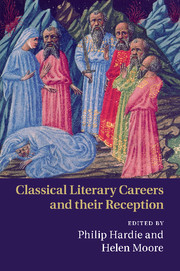Book contents
- Frontmatter
- Contents
- List of contributors
- Preface
- Note on the text
- Introduction: Literary careers – Classical models and their receptions
- 1 Some Virgilian unities
- 2 There and back again: Horace's poetic career
- 3 The Ovidian career model: Ovid, Gallus, Apuleius, Boccaccio
- 4 An elegist's career: from Cynthia to Cornelia
- 5 Persona and satiric career in Juvenal
- 6 The indistinct literary careers of Cicero and Pliny the Younger
- 7 Re-inventing Virgil's Wheel: the poet and his work from Dante to Petrarch
- 8 Did Shakespeare have a literary career?
- 9 New spins on old rotas: Virgil, Ovid, Milton
- 10 Bookburning and the poetic deathbed: the legacy of Virgil
- 11 Literary afterlives: metempsychosis from Ennius to Jorge Luis Borges
- 12 ‘Mirrored doubles’: Andrew Marvell, the remaking of poetry and the poet's career
- 13 Dryden and the complete career
- 14 Goethe's elegiac sabbatical
- 15 Wordsworth's career prospects: ‘peculiar language’ and public epigraphs
- Epilogue: Inventing a life – a personal view of literary careers
- List of works cited
- Index
2 - There and back again: Horace's poetic career
Published online by Cambridge University Press: 10 November 2010
- Frontmatter
- Contents
- List of contributors
- Preface
- Note on the text
- Introduction: Literary careers – Classical models and their receptions
- 1 Some Virgilian unities
- 2 There and back again: Horace's poetic career
- 3 The Ovidian career model: Ovid, Gallus, Apuleius, Boccaccio
- 4 An elegist's career: from Cynthia to Cornelia
- 5 Persona and satiric career in Juvenal
- 6 The indistinct literary careers of Cicero and Pliny the Younger
- 7 Re-inventing Virgil's Wheel: the poet and his work from Dante to Petrarch
- 8 Did Shakespeare have a literary career?
- 9 New spins on old rotas: Virgil, Ovid, Milton
- 10 Bookburning and the poetic deathbed: the legacy of Virgil
- 11 Literary afterlives: metempsychosis from Ennius to Jorge Luis Borges
- 12 ‘Mirrored doubles’: Andrew Marvell, the remaking of poetry and the poet's career
- 13 Dryden and the complete career
- 14 Goethe's elegiac sabbatical
- 15 Wordsworth's career prospects: ‘peculiar language’ and public epigraphs
- Epilogue: Inventing a life – a personal view of literary careers
- List of works cited
- Index
Summary
INTRODUCTION: SOME FRAMEWORKS
This chapter considers the self-constructed poetic career of Quintus Horatius Flaccus (65–8 BC) through his various poetic collections, moving from his debut as writer of hexameter sermo in Satires 1 (35 BC) and 2 (30 BC), through his iambic poetry in the Epodes (30 BC), his lyric activity in Odes 1–3 (23 BC), his reprise of sermo in letter form in Epistles 1 (20/19 BC), his return to lyric in the Carmen Saeculare (17 BC) and Odes 4 (13 BC), to his final phase of epistolary sermo in Epistles 2 and the Ars Poetica (12–8 BC). This catalogue of works presents several patterns: ascent from humble sermo to higher lyric, engagement in different genres at the same time, and (ultimately) a parabolic move from lyric back to sermo. My investigation will be especially interested both in the ‘vertical’ aspect of Horace's career, its representation of the poet's apparent rise from lowly and ‘outsider’ political and poetic beginnings to a more elevated ‘insider’ status in both fields, and its ‘horizontal’ aspect, its representation of the broad variety of genres in which the poet works, sometimes simultaneously.
Discussions of the poetic career in Augustan poetry have mainly concerned themselves with the evident self-fashionings of Virgil's ascent through the Greek hexameter genres and Ovid's parabolic progress through elegy to the Metamorphoses to return to elegy in exile.
- Type
- Chapter
- Information
- Classical Literary Careers and their Reception , pp. 39 - 58Publisher: Cambridge University PressPrint publication year: 2010
- 2
- Cited by



